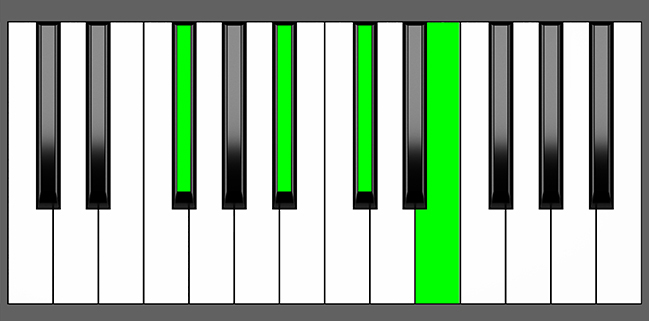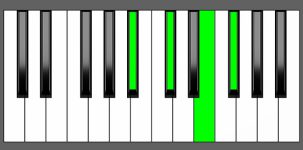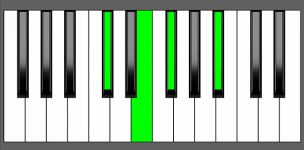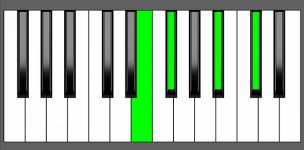Piano Diagram of Gb7 in Root Position

A Gb7 chord is a dominant 7th chord built upon the key of Gb. It’s made by the root note Gb, the major 3rd Bb, the perfect 5th Db, and the minor 7th Fb. The Gb7 chord can be found on the fifth degree of several scales. Keep reading to understand the music theory behind this chord.
Structure of Gb7
Notes |
|---|
| Gb, Bb, Db, Fb |
Intervals |
|---|
| R, 3, 5, m7 |
Fingers Position
Left Hand |
|---|
| 5, 3, 2, 1
5, 4, 2, 1 |
Right Hand |
|---|
| 1, 2, 3, 5
1, 2, 4, 5 |
Gb7 Chord Inversions
The Gb7 chord has a total of 3 inversions:
| Root Position: | Gb | Bb | Db | Fb |
| 1st Inversion: | Bb | Db | Fb | Gb |
| 2nd Inversion: | Db | Fb | Gb | Bb |
| 3rd Inversion: | Fb | Gb | Bb | Db |
Piano Keyboard Diagrams
Music Theory and Harmony of Gb7
What are Dominant Seventh Chords?
A dominant 7th chord is a four-note chord that consists of a major triad with a minor 7th added. Dominant 7th chords are important chords in music theory, as they add a sense of tension and instability that can lead to the resolution of the chord. They have a strong pull toward the tonic, making them common in cadences and progressions.
Let’s see how to build this kind of chord:
Building the Gb7 Chord: Different Approaches
Starting from the Gb Major Scale:
To form a dominant 7th chord, you combine the root, the major 3rd, the 5th, and the minor 7th from a major scale.


To create a Gb7 chord, apply the formula R, 3, 5, m7 in the following manner:
- Begin with the Root note Gb.
- Select the major 3rd interval, which is Bb, and add it to the chord.
- Add the 5th interval, Db.
- Add the minor 7th interval, which is Fb (E).
By following this simple formula, you can create a dominant 7th chord from any major scale.
by Combining Intervals:
One method to create a dominant 7th chord is by combining specific intervals – a major 3rd, a minor 3rd, and again a minor 3rd.
3 + m3 + m3 = Dominant 7th Chords
For example, to create a Gb7 chord, we start with the root note Gb.
We then add a major 3rd interval, which is four half-steps up from the root, to get Bb.
Next, we add a minor 3rd interval, which is three half-steps up from Bb, to get Db.
Finally, we add another minor 3rd interval, which is three half-steps up from Db, to get E which we call Fb to preserve the basic internal structure of the chord. Together, these intervals form the Gb7 chord.
Characteristics of the Gb7 Chord
Dominant 7th chords are often used as transitional chords to add tension and prepare for the resolution to the tonic. They have a distinct sound that is often described as “bluesy” or “jazzy”. From a theoretical point of view, it is an unstable chord because it contains a tritone, an interval of three whole tones between the 3rd and 7th degree.
The ii-V-I Progression
In the theoretical key of Cb major, this progression would involve playing the chords Db minor (ii), Gb7 (V), and Cb major (I) in sequence.
When played as Db minor, Gb major, and Cb major, the progression may sound complete but lacks the tension and resolution provided by the Gb7 chord. The minor 7th interval adds a layer of tension to the progression, creating a sense of expectation for the resolution to the Cb major chord.
How to Use Gb7 in a Chord Progression
The Gb7 chord is a chord that can be used to add tension, create movement, and establish resolution in your chord progressions. It is commonly employed in all genres, from jazz, rock, and pop to folk and traditional music.
The Gb7 chord carries a dominant function, which means it naturally resolves to a chord that represents a point of stability or home within a musical key. Here are some of the most common uses of Gb7:
Most common uses of Gb7
These tables show the harmonized major and natural minor scales where you can find a Gb7 or use it in place of other chords.
Gb7 on Major and minor Scales
| Major Scale | I | ii | iii | IV | V | vi | vii |
|---|---|---|---|---|---|---|---|
| Cb = B | B Maj7 | C# min7 | D# min7 | E Maj7 | F#7 = Gb7 | G# min7 | A#m7b5 |
- Dominant chord in B Major as F#7
| Natural Minor | i | ii | III | iv | v | VI | VII |
|---|---|---|---|---|---|---|---|
| Ab | Ab min7 | Bbm7b5 | Cb Maj7 | Db min7 | Eb min7 | Fb Maj7 | Gb7 |
- Leading Tone chord in Ab minor
Gb7 as Substitute for Gbm7
In this case, the Gb7 chord is derived from the harmonic minor scale and is commonly used as a substitute for a Gbm7 chord on the V degree.
| Natural Minor | i | ii | III | iv | v | VI | VII |
|---|---|---|---|---|---|---|---|
| Cb = B | B min7 | C#m7b5 | D Maj7 | E min7 | F#m7 ⇒ F#7 = Gb7 | G Maj7 | A7 |
- Dominant chord in B minor as F#7
Gb7 in Blues Progressions
| Major Scale | I | ii | iii | IV | V | vi | vii |
|---|---|---|---|---|---|---|---|
| Gb | Gb Maj7 ⇒ Gb7 | Ab min7 | Bb min7 | Cb Maj7 ⇒ Cb7 | Db7 | Eb min7 | Fm7b5 |
| Db | Db Maj7 ⇒ Db7 | Eb min7 | F min7 | Gb Maj7 ⇒ Gb7 | Ab7 | Bb min7 | Cm7b5 |
| Cb = B | B Maj7 ⇒ B7 | C# min7 | D# min7 | E Maj7 ⇒ E7 | F#7 | G# min7 | A#m7b5 |
- Tonic chord in Gb Major
- Subdominant chord in Db Major
- Dominant chord in B Major as F#7
Gb7 in a I III7 Progression
Check F#7 in a I III7 Progression
Gb7 in a Tritone Substitution
The term “Tritone Substitution” is a musical concept where a dominant 7th chord is replaced by another dominant 7th chord that is a tritone away. This means that instead of using the original dominant chord, a musician substitutes it with a chord that is located six semitones above or below the original.
In the context of a ii-V-I chord progression, which is a common jazz chord progression, the tritone substitution can be represented as “ii-SubV7-I”. This means that the ii chord is followed by a substitute dominant 7th chord, which then resolves to the I chord.
| ii | V | I |
| G min7 | C7 | F Maj7 |
| ii | SubV7 | I |
| G min7 | F#7 = Gb7 | F Maj7 |
This type of substitution works because shares the third and 7th notes. This creates a chromatic movement that adds interest and tension, leading towards the tonic chord. The tritone substitution works because the substitute dominant chord shares the same 3rd and 7th notes as the original dominant chord but in reverse order.
For example, if the original dominant chord is C7 (C, E, G, A#), the substitute dominant chord would be Gb7 (Gb, Bb, Db, E), as both chords share the notes E and Bb (A#), which are the 3rd and 7th notes.
It’s important to note that Gb7 is a non-diatonic chord in the key of F. This means that while it may sound good in certain musical contexts, it’s important to be careful and not clash with the melody or other harmonic elements of the composition.
Gb7 as Secondary Dominant Chord
Check F#7 as Secondary Dominant Chord
Gb7 as Dominant Chord in Cb Major
Gb7 as the Leading Tone Chord in Ab minor
In the Ab minor scale, Gb7 is the chord built on the leading tone, which is the 7th note of the scale. This chord creates a strong pull towards the tonic chord, Ab min7.
| i | ii | III | iv | v | VI | VII |
| Ab min7 | Bbm7b5 | Cb Maj7 | Db min7 | Eb min7 | Fb Maj7 | Gb7 |
Gb7 as VII degree – Chord Progressions
These chord progressions can help you understand how Gb7 serves as the leading tone:
i iv VII i
| i | iv | VII | i |
| Ab min7 | Db min7 | Gb7 | Ab min7 |
i VII VI V
| i | VII | VI | v |
| Ab min7 | Gb7 | Fb Maj7 | Eb min7 |
i III VII VI
| i | III | VII | VI |
| Ab min7 | Cb Maj7 | Gb7 | Fb Maj7 |
i iv VII III
| i | iv | VII | III |
| Ab min7 | Db min7 | Gb7 | Cb Maj7 |
Circle Progression
| i | iv | VII | III | VI | ii | V7 | i |
| Ab min7 | Db min7 | Gb7 | Cb Maj7 | Fb Maj7 | Bbm7b5 | Eb7 | Ab min7 |
Gb7 as Dominant chord in Cb minor
Gb7 as Tonic Chord in a Blues Progression in Gb
In the key of Gb major, the first chord is a Gb Maj7 but in some contexts, it can be substituted with a Gb7.
| I | ii | iii | IV | V | vi | vii |
| Gb Maj7 ⇒ Gb7 | Ab min7 | Bb min7 | Cb Maj7 ⇒ Cb7 | Db7 | Eb min7 | Fm7b5 |
One such context is in the blues genre, where the use of dominant 7th chords as tonics is common.
Blues music draws its foundation from the Mixolydian scale, which is a variation of the major scale. The Mixolydian scale is characterized by having a flattened 7th note compared to the major scale.
When we consider the key of Gb major, the 7th note is F. However, in the Mixolydian scale used in blues music, the 7th note is flattened, which means it is lowered by a half step. Consequently, the F note in the Gb major scale becomes an E (Fb) in the Mixolydian scale.
This alteration of the 7th note from natural F to Fb in the Mixolydian scale is significant because it creates a minor 7th interval. In other words, when we build a dominant 7th chord on the tonic Gb using the Mixolydian scale, we get a Gb7 chord.
It is this altered 7th note and the resulting minor 7th interval that contributes to the bluesy and soulful atmosphere associated with the genre.
In the context of blues music, a Gb7 chord can serve as:
- the tonic chord (I) in the key of Gb,
- the subdominant (IV) in the key of Db,
- the dominant chord (V) in the key of Cb.
This is because blues music uses a specific chord progression known as the 12-bar blues, which consists of three chords played over 12 bars.
| I | I | I | I |
| IV | IV | I | I |
| V | IV | I | V |
Gb7 as I degree in a Blues Progression in Gb
In the key of Gb, the 12-bar blues progression would typically be Gb7 (I), B7 (IV), and Db7 (V) chords, with the Gb7 chord serving as the tonic and the other two chords as the subdominant and dominant, respectively.
Blues Chord Progression in Gb
| I7 | IV7 | I7 | V | IV7 | I7 | V | |||||
| Gb7 | Gb7 | Gb7 | Gb7 | Cb7 | Cb7 | Gb7 | Gb7 | Db7 | Cb7 | Gb7 | Db7 |
Blues Chord Progression in Gb – Variation
| I7 | IV7 | I7 | IV7 | I7 | V | IV7 | I7 | IV7 | I7 | V | |||
| Gb7 | Cb7 | Gb7 | Gb7 | Cb7 | Cb7 | Gb7 | Gb7 | Db7 | Cb7 | Gb7 | B7 | Gb7 | Db7 |
Gb7 as Subdominant Chord in a Blues Progression in Db
In a blues progression in the key of Db, the Gb7 chord can serve as a subdominant chord. In this context, the Gb7 chord is typically played in the fifth, sixth, and tenth measure of a twelve-bar blues progression.
| I | ii | iii | IV | V | vi | vii |
| Db Maj7 ⇒ Db7 | Eb min7 | F min7 | Gb Maj7 ⇒ Gb7 | Ab7 | Bb min7 | Cm7b5 |
Gb7 as IV degree in a Blues Progression in Db
Blues Chord Progression in Db
| I7 | IV7 | I7 | V | IV7 | I7 | V | |||||
| Db7 | Db7 | Db7 | Db7 | Gb7 | Gb7 | Db7 | Db7 | Ab7 | Gb7 | Db7 | Ab7 |
Blues Chord Progression in Db – Variation
| I7 | IV7 | I7 | IV7 | I7 | V | IV7 | I7 | IV7 | I7 | V7 | |||
| Db7 | Gb7 | Db7 | Db7 | Gb7 | Gb7 | Db7 | Db7 | Ab7 | Gb7 | Db7 | Gb7 | Db7 | Ab7 |
Gb7 as Dominant Chord in a Blues Progression in Cb
Check F#7 in a Blues Progression in B
Gb7 as III7 Degree in D Major
Alternative Gb7 Nomenclature
- Gb7
- Solb 7
- Gb 7th
- Gb dom7
- Gb dominant 7th
Conclusion
The chord progressions and examples presented in this post provide a comprehensive overview of the most common uses of the Gb7 chord. It’s important to note, however, that many advanced harmony-related topics could not be included due to space constraints. These topics include chord progressions built on harmonic and melodic scales, modal scales, hidden tonality, secondary dominants and other chord substitutions, non-functional harmony and atonal music, modal interchange and borrowed chords, voice leading and counterpoint, chromatisms, jazz harmony…I mean, music theory is a huge topic!
Although I couldn’t cover all of these topics in my post, I encourage readers to continue exploring these areas in their own study and research. By expanding your knowledge in these advanced areas of music theory, you can gain a deeper understanding of the harmonic possibilities that exist beyond the basics presented here.



